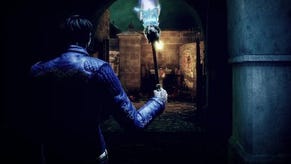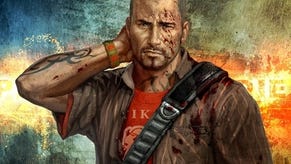Shadows of the Damned
A matter of light and death.
It was perhaps inevitable that a new action horror game involving Shinji Mikami would echo certain elements of Resident Evil 4, such as the claustrophobic camera angle you're forced into whenever you go to fire your gun.
It was also inevitable that a game involving his colleague, Goichi Suda, would pulse with toilet humour. So when we sit down to play Shadows of the Damned for the first time at GDC, these elements don't come as much of a surprise.
However, it's fun to observe the subtler things that these two feted game designers have learned and recalled from their earlier, seemingly dissonant output.
Their videogames have a charming habit of expecting you not just to overlook the absurdity of their systems – like inventory management during a zombie apocalypse, or mowing lawns to get money to pay for stuff so you can fight people with a laser sword – but to revel in them.
The only way that Shadows of the Damned is different is that it not only gets this, but takes things to their logical conclusion. Pretty much nothing that happens in Shadows of the Damned makes sense, but it doesn't matter, because there's internal consistency and everyone's very earnest about what's going on.
What's going on is that you play a leather-clad, tattoo-covered, hard-drinking man named Garcia Hotspur. You're on a mission to rescue your Taylor Swift lookalike girlfriend Paula from Fleming, the king of all demons, who has trapped her in Hell as part of a sick game he's playing with you.

Those are the sensible bits. You are accompanied on your quest by a talking demon called Johnson, who takes the form of a disembodied, fiery skull, sounds like he's from somewhere west of Salisbury and can transform into upgradeable weapons called things like "Boner".
Rather like Alan Wake, Shadows of the Damned is a game built around the manipulation of light and darkness. Rather unlike Alan Wake, darkness spreads as a slow-moving purple veil that emboldens enemies and changes the status of doorways.By wading into it and striking at Darkness Hands (literally hands that spew the darkness) you can turn it off.
Doorways, incidentally, are sometimes covered in Demon's Pubes (I'm not making this up) which restrict your progress until they're dispatched by shooting particular things nearby, under cover of the purple darkness.
Shadows of the Damned is also host to those quintessentially Japanese action/horror game cut-scenes that luxuriate in character detail and obscure, garrulous dialogue.
Upon entering a paved courtyard under a massive neon sign that says "WELCOME TO HELL", for example, you're assailed by the operatic siren calls of a strikingly (read: sadistically) dressed young lady on a balcony. She pirouettes and wails for much longer than is necessary to get the point, before Johnson explains who she is and why this is scary.













